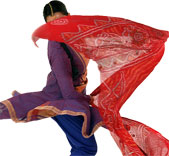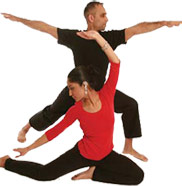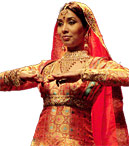KATHAK
Origin
One of the most major classical dances of North India is Kathak. The word" Kathak signifies to tell a story. The story goes like this when in the olden days when the patronage transformed from the temple to the royal court, there was complete transformation in the overall emphasis in telling stories. The focus changed from religious stories to that of entertainment. Today, the story telling part remains with it and the dance holding the primary role.Primarily Kathak dance was associated with an institution called Tawaif. It is something like Ghesia tradition of Japan. Tawaif was a profession which would demand highest standards of training, intelligence and civility - to be able to learn Kathak. But when the Britishers came to rule India, giving Tawaif a bad name and that was the beginning of Tawaif into a downtrail spiral. But today after Independence struggle Kathak is regarded as one of the most renowned dance form which represents India. The costume of the dance is designed with lots of paint applied on the face of the artist.
Steps involved in the dance
 The audience can feel the invisible presence of dreams and ambitions through circular movements, delicate footsteps and subtle expressions. The dance involves slow and medium tempos; the dancer can find enough space for improvisations and suggestive bhavas or emotions.
The audience can feel the invisible presence of dreams and ambitions through circular movements, delicate footsteps and subtle expressions. The dance involves slow and medium tempos; the dancer can find enough space for improvisations and suggestive bhavas or emotions.The pomp and the extravagant magnificence of Kathak is partly due to its decor, part of which include the "Kireetam" or huge head gear, the "Kanchukam" or the over sized jacket, and the long skirt worn over a thick padding of cushions.Make-up which is of five types- Pacha, Kathi, Thadi, Kari and Minukku.
 Kathak dance has three- Gharanas - the school of kathak which are named as per the geographical areas in which they are developed they are Jaipur, Lucknow and Benaras Gharanas. All compositions in Kathak dance are performed in a way so that the final step and the beat of the composition lands on the 'Sam' or the first beat of the cycle.Most compositions also have bols" which serve both as mnemonics to the given composition for which their recitation also acts as a part of the performance. In addition to these "Tukras" are also formed to highlight the specific aspects of kathak.
Kathak dance has three- Gharanas - the school of kathak which are named as per the geographical areas in which they are developed they are Jaipur, Lucknow and Benaras Gharanas. All compositions in Kathak dance are performed in a way so that the final step and the beat of the composition lands on the 'Sam' or the first beat of the cycle.Most compositions also have bols" which serve both as mnemonics to the given composition for which their recitation also acts as a part of the performance. In addition to these "Tukras" are also formed to highlight the specific aspects of kathak. In Kathak dance there is lot of significance given to the Feet Mudra than the Hand Form. These dances are performed straight-legged and the ankle bells called ghungaroo worn by the dancers are adeptly controlled.
Popular dancers
Ruby Mishra, Kalamandalam Radhika, Kalamandalam Rajeev, Thengin Thottathil Ramankutty Nair, Thekinkattil Ramunni Nair, Madavoor Vasudevan Nair, Kudamaloor Karunakaran Nair, Kottakkal Krishnan Kutty Nair,Keezhpatam Kumaran Nair, Vazhenkata Kunchu Nair, Mankulam Vishnu Namboodiri, Kalamandalam Kesavan Namboodiri, Gopi Nath, Kalamandalam Krishnan Nair, Vellinezhi K. Nanu Nayar, Kottakkal Sivaraman, Oyoor Kochugovinda Pillai, Mankompu Sivasankara Pillai, Chennithala Cheliappan Pillai, Chengannur Raman Pillai, Thotton Karakkadan, Chandu Panikkar, Mampuzha Madhava Panicker, Kurichi Kunjan Panicker, Kavungal Sankarankutty Panicker, Kavungal Chathunni Panicker, Champakulam Pachu Pillai, Kalamandalam Ramankutty Nair, Kalamandalam Vasu Pisharody, Guru Kunchu Kurup Today, Kathak is popular not only in India but all over the world; this dance is recognised as one of the seven classical dance forms of India. Kathak's dance composition and its unique history has made it very different from other traditional dance forms. Presently classical dance Kathak is characterized by a combination of the temple and court forms which includes both the devotion and romantic form that has shaped it through the years. The influence of theatre in the dance has presented itself in the movement towards dance productions of stories such as Shakuntala. The dance embodiment of expressive motion, rhythmic accuracy, the dancers graceful turning, poised stances, technical clarity, hand gestures called mudras and subtle expression known as bhava-abhinaya are important components of modern Kathak.
Today, Kathak is popular not only in India but all over the world; this dance is recognised as one of the seven classical dance forms of India. Kathak's dance composition and its unique history has made it very different from other traditional dance forms. Presently classical dance Kathak is characterized by a combination of the temple and court forms which includes both the devotion and romantic form that has shaped it through the years. The influence of theatre in the dance has presented itself in the movement towards dance productions of stories such as Shakuntala. The dance embodiment of expressive motion, rhythmic accuracy, the dancers graceful turning, poised stances, technical clarity, hand gestures called mudras and subtle expression known as bhava-abhinaya are important components of modern Kathak.The work of the Maharaj family of dancers like the Acchan Maharaj, Shambhu Maharaj, Lachhu Maharaj and one of the greatest current dancers still alive today, Birju Mahara has been extremely successful in spreading the popularity of Kathak all over the world.
Kathak is considered as one of the seven classical dance forms of India. It is characterized itself by fast footwork (tatkar) and pirouettes (chakar). It has today a unique form that has been influenced by various times in the past by narratives of mythological lores, temple dances, the bhakti movement and court dances in the 19th century. Performers today generally draw their lineage from two major schools of Kathak: the Jaipur gharana and the Lucknow gharana born in the courts of the Kachwaha Rajput kings and the Nawab of Oudh respectively.
Learning Kathak
Nupur Kathak AcademyBasement Rumka Complex,
Opp. Sony World,
Shrenic Cross Road, Akota
Vadodara Ph: 0091 265 6453106
(M): 0091 9327492621


